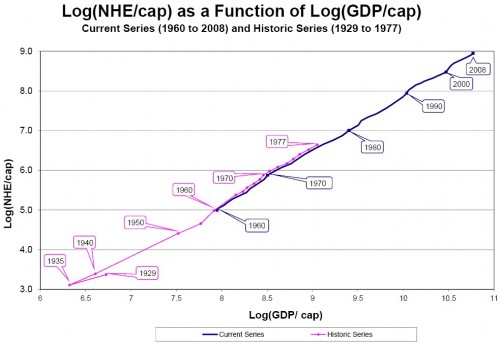If health is a luxury good, why should we expect the health spending trajectory to change?
The chart shows that on a log-log scale, the relationship between per capita national health expenditures and per capita GDP is ram-rod straight and has been since 1935.* Based on several statistical tests, Woodward and Wang conclude that there are
no significant changes in either the intercept or the slope for the years of any of the major reforms of the period, including the introduction of Medicare and Medicaid in 1966, in the years following Nixon’s Wage and Price Controls and the health planning legislation of the early 1970s, in the years following Medicare’s introduction of the Prospective Payment System in 1984, or after the widespread adoption of managed care in the 1990s.
With such overwhelming evidence from our past that, despite our efforts, this national health spending curve has not bent, why do we think the future will be much different?
The solution to the need for security at US airports is not a government bureaucracy. The solution is to allow the private sector, preferably the airlines themselves, to provide for the security of their property. As a recent article in Forbes magazine eloquently stated, “The airlines have enormous sums of money riding on passenger safety, and the notion that a government bureaucracy has better incentives to provide safe travels than airlines with billions of dollars worth of capital and goodwill on the line strains credibility.
via paul.house.gov
